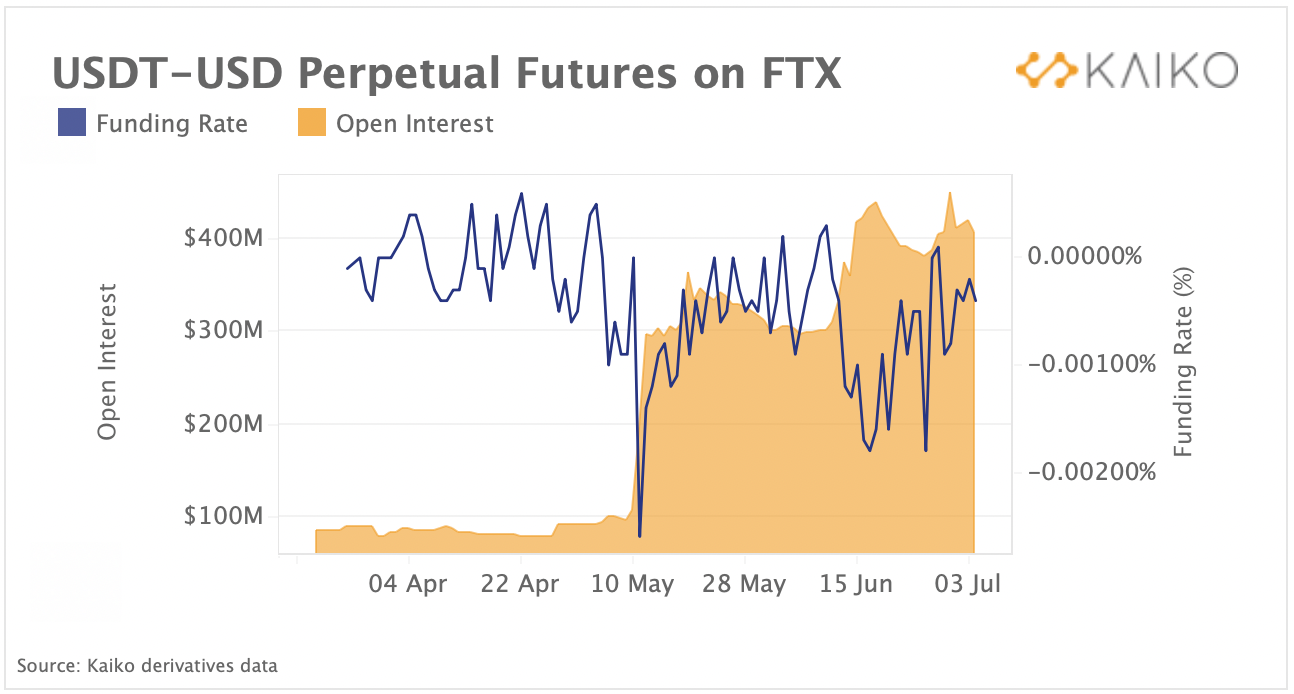Rumors on USDT’s true reserve backing seem to have borne institutional action. According to Kaiko research, open interest involving USDT stablecoin increased by over 3x since Terra (LUNA) met its demise.
Open interest measures the total number of derivative contracts, options or futures, that are yet to be settled. In the case of USDT’s perpetual futures on the FTX exchange, they don’t have an expiry date. Instead, they are funded close to the underlying asset’s price.

There is little downside to betting against an asset such as stablecoin, as it is more likely to de-peg in severe market stress. Not only did hedge funds pick USDT on FTX for this scenario, but DeFi traders are also concerned that this might happen.
Curve’s Tri-Pool USDT Allocation
USDT open interest action closely follows crypto contagion events. First, the loss of Terra’s UST stablecoin peg in May, and second, the suspension of Celsius Network’s withdrawals in June. This indicates shorting action against USDT.
Specifically, given that it is a stablecoin, betting that USDT will depreciate following more fear and more waves of redemption from USDT to USD.
This has already manifested in Curve Finance’s liquidity pool. Its Tri-Pool stablecoin allocation has been drastically reconfigured since May. Consisting of three stablecoins—USDC, DAI, and USDT—3Pool provides multi-billion stable liquidity for DeFi traders.

USDT’s 3Pool share more than doubled, sitting at 24.5% on May 1st, having significantly increased since Terra (LUNA) ecosystem collapsed. Presently, it is at 64.2% allocation.

Such an increase indicates investors’ concern that USDT too may be subjected to de-pegging. Meaning, that the off-kilter imbalance suggests that more traders are eager to swap USDT for other stablecoins. Unfortunately, there were more than rumor mills to back up that concern throughout USDT’s history.
Is USDT Properly Backed?
Having launched in 2014, Tether (USDT) had plenty of time to establish itself as the largest stablecoin by market cap. However, stablecoin is only as good as its backing. In extreme market conditions, if people decide to redeem it for USD en masse, its peg should remain stable.
If stablecoin tokens are not backed with cash reserves, in a 1:1 ratio for every token, a bank run occurs, pulling the peg rug. Although Tether publishes audit reports on the state of its reserves, the Commodity Futures Trading Commission (CFTC) ordered Tether to pay $41 million to settle charges for misleading statements on its backing.
That was in October 2021. Since then, in December 2021, Tether representatives conspicuously failed to appear before the largest congressional hearing on stablecoins. Moreover, there were claims that Tether’s reserves are not backed by cash reserves, but by Chinese/Asian commercial paper to the tune of 85%.
While Tether dismissed these claims, during Terra’s meltdown USDT did briefly lose its peg down to $0.97.

Fearing the Terra-induced death spiral, investors redeemed over $10 billion in USDT since. This suggests that rumors were unfounded. Even Sam Bankman-Fried, the head of FTX and crypto bailout king, dismissed Tether’s backing concerns as unfounded in his recent interview with Forbes.
“I think that the really bearish views on Tether are wrong…I don’t think there is any evidence to support them.”
Nonetheless, USDT lost -20.7% of its market cap since its May ATH of $83.2 billion, but still holds the lion’s share of the total stablecoin marketcap at $65.9 billion. USDC stepped in to fill that drop, having raised its market cap by +14.2%, from $48.8 billion in May to the present $55.8 billion.

Join our Telegram group and never miss a breaking digital asset story.
Is Tether (USDT) De-Pegging Likely?
Needless to say, de-pegging of the largest stablecoin would make Terra’s meltdown seem like a minor inconvenience. To ensure that doesn’t happen, Tether continues to eliminate its commercial paper collateral.
Last Friday, Tether announced that it has $8.45 billion allocated to these assets. On July 31, $5 billion will expire, leaving commercial paper collateral at its lowest point of $3.5 billion. This represents 5.3% of USDT’s current total market cap, with the end goal to bring it down to zero.
This is in line with crypto regulations across the world, requiring stablecoins to be 100% backed by cash reserves. Although the global crypto market cap sank by -69%, from ATH of $2.9 trillion to $873 billion, it is exceedingly unlikely that more extreme bottoms are on the horizon.
Lastly, in his recent appearance on the Saifedean podcast, Tether CTO Paolo Ardoino revealed that they managed to redeem $7 billion in 48 hours. This is a task that even large commercial banks would have trouble handling.
Do you think algorithmic stablecoins will never again receive mainstream adoption? Let us know in the comments below.
 tokenist.com
tokenist.com